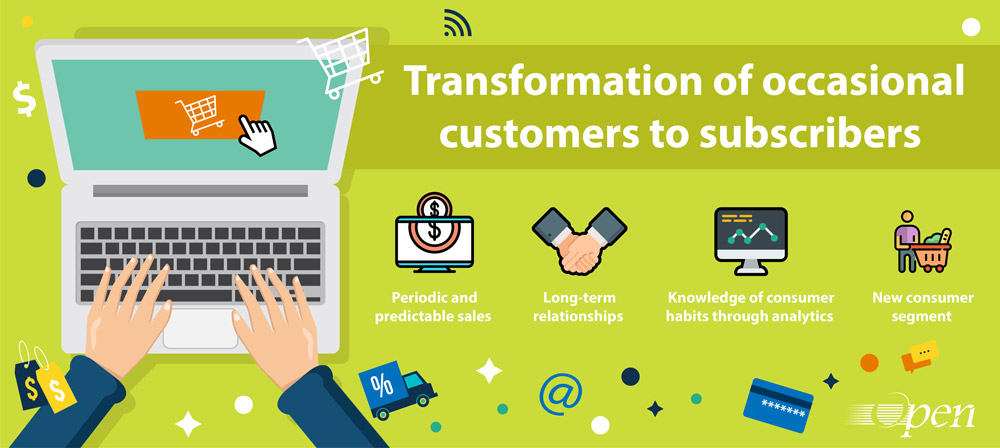Compared to the traditional model, sales-by-subscription offers nine times faster growth for the retail business, thanks to the creation of long-term relationships that provide the opportunity to obtain continuous sales.
The modern customer seeks to obtain a wide variety of products and services in an immediate, efficient and safe manner; they often wish to make their purchase online and expect a range of possible payment options. The massive use of the internet in everyday life has transformed the behavior of consumers and is beginning to disrupt traditional business models.

These new conditions might represent an opportunity for traditional retailers who want to create long-term relationships with their customers. In order to achieve this, they have devised the strategy of the “Membership Economy”, the objective of which is to transform an occasional client into a member. This strategy requires careful analysis of the needs and purchasing patterns of each customer in order to devise attractive offers and ensure constant sales.
A basic subscription model permits the continuous leasing of products and services. The membership model goes one step further by granting privileges such as discounts, special offers, multiple payment methods, and even finance options; all of which serve to make the customer feel more valued and improve their opinion of the business. Companies can use this enhanced relationship to sell upgrades, direct customers to other business areas or suggest related products and services.
In the United States, you can buy a subscription for anything from entertainment to toothbrushes. This situation leaves traditional retailers vulnerable as companies embracing subscription services and e-commerce platforms quickly gain ground against those who resist change.
The Cloud Services industry has achieved rapid growth using the subscription-based model and shows no signs of slowing down. According to Gartner, the worldwide public cloud services market is projected to grow 18 percent in 2017 to a total of $246.8 billion(1).
In contrast, the video game retailer GameStop (NYSE:GME) has resisted the trend towards e-commerce and subscription sales. With 2016 holiday-season sales down 13.6% from the previous year, CEO Paul Raines has cited competition with digital sales as the main reason for the decline and announced the closure of at least 150 stores(2).
Surprisingly, the subscription model has been around for a long time. As John Warrillow explains in his book(3), the subscription model has existed since the sixteenth century in Europe, where an enterprising cartography business invited their customers to subscribe to future editions of their maps. The difference between this subscription model and the present one lies in the transformation of the company-consumer relationship enabled by digital tools.
There are 3 new types of subscription model which are unique to the 21st century and have shown great success in the modern market. The first such model involves providing customers with surprise boxes which contain sample products (usually from the fashion or beauty industry); customers then proceed to place orders for these products based on their satisfaction with the samples. The second model allows the consumer to receive products for a specific time or enjoy short-term on-demand services such as video streaming; this model is in stark contrast to the traditional property model however it has quickly gained acceptance from consumers. The last type of subscription model gives consumers the possibility to pay leases for long-term services such as mobility and music services.
At present, 106 million people worldwide pay for a subscription to a music platform; this type of service replaces the need to buy a physical album, thus saving the consumer money and reducing demand for hardcopy music formats(4). This consumer behavior has led companies like Amazon (NASDAQ:AMZN) to see 26% growth in their shares over the past year (outperforming the S&P 500 by more than 13%)(5). Amazon has turned into the online retailer that dominates the electronic commerce world with first-quarter sales up 23% this year, following an unbroken 20-year streak of double-digit revenue growth(6).
The number of subscribers to Amazon´s membership service, Amazon Prime, has reached 80 million members, up 58 million from the same time last year. Amazon Prime members pay $ 99 USD per year to enjoy discounts on delivery, music, video streaming and photo storage. By keeping customers engaged with the website, Amazon has managed to consolidate a growing base of high-spending customers. Estimates from CIRP (Consumer Intelligence Research Partners) show that Amazon Prime members spend $1,300 per year on average, compared with $700 for non-members(7).
In the subscription business model, there are key factors which determine success and create advantages over other suppliers, such as engagement, responsiveness, personalized relationships and improved customer experience. This model is complemented well by the provision of multiple payment options with a focus on long-term recurring payments.
Sales-by-subscription offers multiple benefits for both the company and the consumer. Companies gain advantages such as steady cash-flow, access to new market segments and a better ability to get to know their consumers. Having an ongoing relationship with consumers is vital; not only for customer satisfaction but also for gathering the necessary information to create offers which suit their specific needs and tastes. However, companies are not the only ones who benefit from the subscription model; the subscribers enjoy special offers, online purchasing, multiple payment options and being alleviated of the burdens of product ownership.
Because subscription and e-commerce are the main drivers of growth in the retail market, traditional retailers must overcome the challenge of adopting this new model or be left behind. It is essential to be well-equipped for maintaining subscriptions, monitoring consumer usage patterns, implementing consumer benefits and ensuring long-term customer engagement. For this reason, retailers should aim to support their operation with technological solutions that provide control over payment platforms, customer interactions, inventory management, remote service activation, sales requests and customer analytics. With such a system in place, the transition into the membership economy will come with ease.
(1) Pettey, C. (2017, September 3). Gartner: http://www.gartner.com/newsroom/id/3616417
(2) Liptak, A. (2017, September 3). The Verge: https://www.theverge.com/2017/3/25/15059380/gamestop-store-closings-2017-digital-sales-collectibles-business
(3) Warrillow, J. (2015). The Automatic Customer: Creating a Subscription Business in Any Industry. Penguin
(4) Ingham, T. (2017, September 3). Music Business Worldwide: https://www.musicbusinessworldwide.com/music-streaming-finally-has-more-paying-subscribers-than-netflix/
(5) Stock quotes retrieved 3rd September 2017. https://www.bloomberg.com/quote/AMZN:US
(6) Soper, S. (2017, September 3). Bloomberg: https://www.bloomberg.com/news/articles/2017-04-27/amazon-s-spending-has-little-effect-on-revenue-profit-growth
(7) Pandolph, S. (2017, September 3). Business Insider: http://www.businessinsider.com/amazon-prime-subscribers-hit-80-million-2017-4









